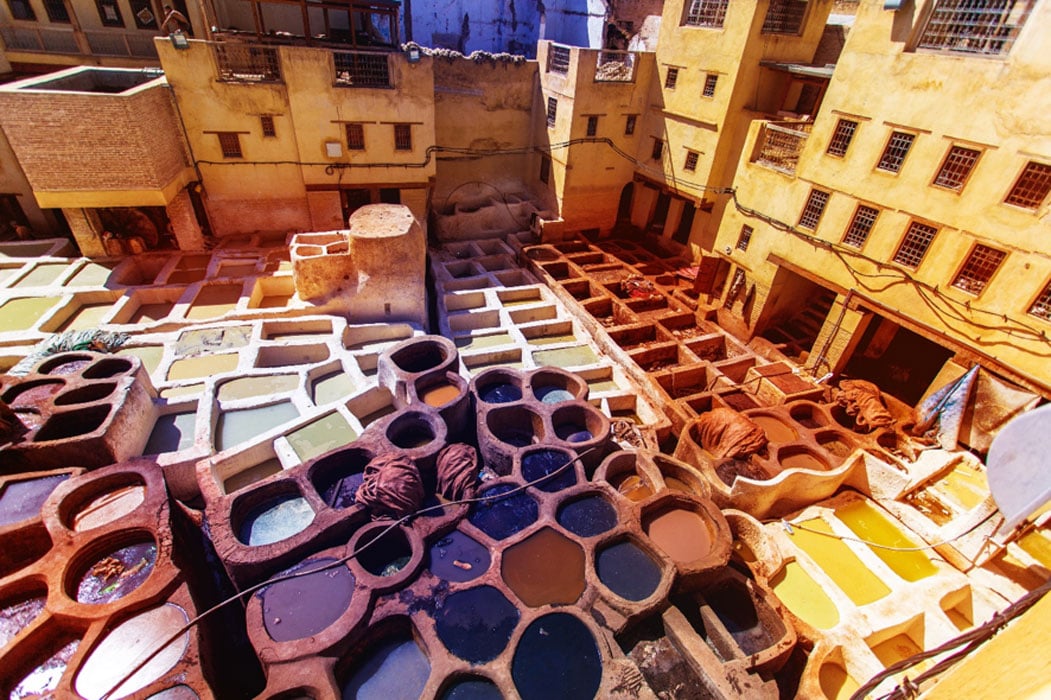The Ancient and Vibrant Leather Tanneries of Fez, Morocco
Fez is one of the most important cities in Morocco. Located in the northern part of the country, this ancient city served as Morocco’s capital for centuries. The historic part of the city, known also as the Medina of Fez, is a UNESCO World Heritage Site, and one of the site’s attractions is the Chouara Tannery, the largest tannery in the city.
Founding Fez
The history of Fez goes all the way back to the late 8th century AD. At that time, Morocco was ruled by the Idrisid Dynasty. The founder of the dynasty, Idris I, decided that the current capital, Oualili (the ancient Roman city of Volubilis), was not grand enough, and made plans for a new capital. Before his plans could be put into action, however, Idris died. As a result, it was Idris’ successor, Idris II, who is given the credit of founding Fez.

View of the Old Medina. (Davide Cesare Veniani/CC BY SA 3.0)
Although the fortunes of Fez fluctuated over the centuries, it retained its status as Morocco’s capital for much of the country’s history. Over the centuries, Fez built up its reputation as a major Islamic spiritual center, as well as an important city on the trans-Saharan trade route. Moreover, Fez became renowned for its leather production industry, which it has retained till this day.
- The Oldest University in the World May Not Be Where You Think And the Founder May Also Surprise You
- The Ancient Tuaregs, Lost Lords of the Sahara
- How the Sultan Moulay Ismail of Morocco Sired 1,000 Children
Following Traditions in Fez’s Leather Tanneries
The leather industry in Fez began as early as the city’s foundation, and is still in operation today. Arguably the most impressive sign of this industry is its tanneries, three of which are still in extant today. The largest of the three tanneries of Fez is the Chouara Tannery, which is also one of the city’s most iconic sights. The Chouara Tannery is reputed to be the oldest tannery in the world, and the site has not changed since the 11th century.

Overview of the Chouara leather Tannery. (Alacoolwiki/CC BY SA 4.0)
Not only has the physical structures of the tannery been left intact, but the techniques used for the tanning of leather have changed little since the time of the Idrisids. Like their Medieval forebears, the leather tanners of Fez today carry out their work completely by hand, without the aid of modern machinery.

The leather tanners of Fez today still carry out their work completely by hand. (CC0)
Prepping Hides at the Chouara Tannery
The first step of the tanning process involves the soaking of the hide in vats containing a mixture of cow urine, quicklime, salt, and water. These rectangular vats contribute partially to the infamous pungent odor of the Chouara Tannery. The aim of this step is to remove any fat, flesh, and hair that have remained on the hides. The hides are left in these vats for 2-3 days before being removed, then the undesirable elements are scraped off.

Hides at Chouara Tannery, Fez, Morocco. (Arthur Chapman/CC BY NC SA 2.0)
The hides are almost ready to be dyed. Before this step is done, however, the hides need to be soaked in vats containing pigeon poop diluted in water. This process serves to soften the hides, which allows for better absorption of the colorants later on during the dyeing process. The hides are usually kneaded by foot for up to three hours.
The hides are then soaked in round vats containing natural plant dyes. The color of these dyes depends on the type of plants used. For instance, red is obtained from poppy flowers, orange form henna, yellow from saffron, green from mint, blue from indigo, and brown from cedar wood. The hides can be sunk by hand into these vats, or a tanner can jump up and down on a pile of hides in the vats. After the dyeing is completed, the hides are removed from the vats and hung up to dry.
- Once At the Far Reaches of the Roman Empire, Volubilis Rises Once More in Morocco
- Breaking News! 300,000-Year-Old Remains Place Oldest Homo Sapiens in Morocco
- Ancient Carved Eye-Witness Accounts Show Martian Invaders Attacking the Moroccan Landscape

The hides can be sunk by hand into these vats, or a tanner can jump up and down on a pile of hides in the vats. (CC0)
At the Chouara Tannery, the whole tanning process is visible from the terraces surrounding the site. Incidentally, these terraces are also the shops where the finished leather products are sold. Between 2015 and 2016, restoration work was carried out on the environs surrounding the tannery to touch up their crumbling façades.

At the Chouara Tannery, the whole leather tanning process is visible from the terraces surrounding the site. (just_a_cheeseburger/CC BY 2.0)
Top image: Scraping hides at the Chouara Tannery, the largest of the Fez’s leather tanneries and the oldest in the world. (Tatyana Gladskih / AdobeStock)
By Wu Mingren
References
dzamonja, 2019. Chouara Leather Tannery. Available at: https://www.atlasobscura.com/places/chouara-leather-tannery
Fez Tannery, 2019. Fez Tannery Leather Process. Available at: https://feztannery.com/fes-tannery-process/
Kaushik, 2014. The Leather Tanneries of Fez, Morocco. Available at: https://www.amusingplanet.com/2014/08/the-leather-tanneries-of-fez-morocco.html
Kirsty, 2017. Visiting the Leather Tanneries of Fez in Morocco. Available at: http://www.kathmanduandbeyond.com/leather-tanneries-fez-morocco/
Lonely Planet, 2019. Chaouwara Tanneries. Available at: https://www.lonelyplanet.com/morocco/fez/attractions/chaouwara-tanneries/a/poi-sig/1143430/355510
Lonely Planet, 2019. Fez, History. Available at: https://www.lonelyplanet.com/morocco/fez/background/history/a/nar/7086f078-519b-4bf5-9ec2-69ff446c6d77/355510



















